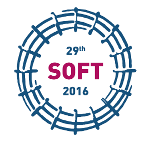Speaker
Carmen Garcia-Rosales
(Materials Department)
Description
Tungsten is presently the main candidate material for the first wall armour of future fusion reactors. However, if a loss of coolant accident with simultaneous air ingress into the vacuum vessel occurs, the temperature of the in-vessel components would exceed 1000ºC, leading to the undesirable formation of volatile and radioactive tungsten oxides. A way to prevent this serious safety issue is the addition of oxide-forming alloying elements to pure tungsten which, in presence of oxygen at high temperatures, promote the development of a self-passivating oxide layer and protects tungsten against further oxidation.
In this work, bulk tungsten alloys of the W-Cr-Y system with different concentrations of the alloying elements are studied in order to establish their optimum composition for lowest possible oxidation rate and best self-passivating behaviour together with acceptable thermal and mechanical properties. The materials are manufactured by mechanical alloying and subsequent densification by hot isostatic pressing. Microstructural investigations of the bulk material and the thin oxide layer developed after oxidation as well as the thermal conductivity and mechanical properties of the alloys at different temperatures are presented. The W-Cr-Y alloys exhibit an ultrafine grained microstructure with an average grain size around 100 nm. A summary of the results of different tests under conditions relevant to the expected operation as first wall material is shown: oxidation tests under isothermal and accident-like conditions; high heat flux tests at GLADIS (Garching Large Divertor Sample Test Facility) up to 2 MW/m², according to the power load expected at the blanket first wall; and thermal-shock tests at JUDITH (Juelich Divertor Test Facility Hot Cells) to simulate e.g. loads by photon flashes occurring at the first wall of a DEMO. Compared to previous alloys of the system W-Cr-Ti, the W-Cr-Y alloys exhibit significantly lower oxidation rates both under isothermal and accident-like conditions.
Co-authors
Aida Calvo
(Materials Department, CEIT-IK4, Paseo de Manuel Lardizabal 15, E-20018 San Sebastian, Spain;Tecnun, University of Navarra, Paseo de Manuel Lardizabal 15, E-20018 San Sebastian, Spain)
Andrey Litnovsky
(Institute of Energy and Climate Research – Plasmaphysics, Partner of the Trilateral Euregio Cluster (TEC), Forschungszentrum Jülich GmbH, 52425 Jülich, Germany)
Carmen Garcia-Rosales
(Materials Department, CEIT-IK4, Paseo de Manuel Lardizabal 15, E-20018 San Sebastian, Spain;Tecnun, University of Navarra, Paseo de Manuel Lardizabal 15, E-20018 San Sebastian, Spain)
Elena Tejado
(Department of Materials Science, Polytechnic University of Madrid, Profesor Aranguren s/n, E-28040 Madrid, Spain)
Freimut Koch
(Max-Planck-Institut für Plasmaphysik, Boltzmannstr. 2, D-85748 Garching, Germany)
Gerald Pintsuk
(Institute of Energy and Climate Research – Plasmaphysics, Partner of the Trilateral Euregio Cluster (TEC), Forschungszentrum Jülich GmbH, 52425 Jülich, Germany)
Henri Greuner
(Max-Planck-Institut für Plasmaphysik, Boltzmannstr. 2, D-85748 Garching, Germany)
Inigo Iturriza
(Materials Department, CEIT-IK4, Paseo de Manuel Lardizabal 15, E-20018 San Sebastian, Spain)
Jose Ygnacio Pastor
(Department of Materials Science, Polytechnic University of Madrid, Profesor Aranguren s/n, E-28040 Madrid, Spain)
Karsten Schluter
(Max-Planck-Institut für Plasmaphysik, Boltzmannstr. 2, D-85748 Garching, Germany)
Marcin Rasinski
(Institute of Energy and Climate Research – Plasmaphysics, Partner of the Trilateral Euregio Cluster (TEC), Forschungszentrum Jülich GmbH, 52425 Jülich, Germany)
Nerea Ordas
(Materials Department, CEIT-IK4, Paseo de Manuel Lardizabal 15, E-20018 San Sebastian, Spain)
Rudolf Neu
(Max-Planck-Institut für Plasmaphysik, Boltzmannstr. 2, D-85748 Garching, Germany)
Tobias Wegener
(Institute of Energy and Climate Research – Plasmaphysics, Partner of the Trilateral Euregio Cluster (TEC), Forschungszentrum Jülich GmbH, 52425 Jülich, Germany)

